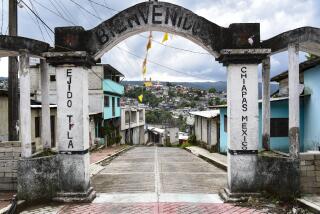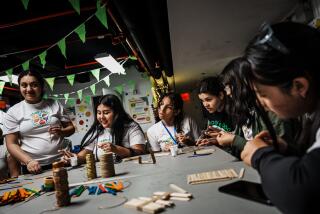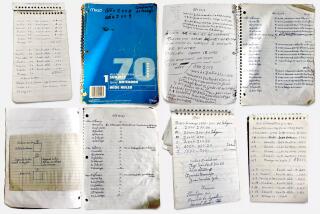Memories of Guatemala
- Share via
Inside the large coffin-shaped box that arrived from Guatemala, the four refugees found many beautiful things that reminded them of home.
Hurriedly, Antonio Lopez and his friends, all Guatemalan Indians of the Kanjobal ethnic group, pried open the wooden box. Hidden under a dozen letters, hand-made sweaters and other gifts from their relatives, they found what they were most waiting for--a brand-new marimba, a xylophone-type instrument made of cypress wood.
“The marimba is the national instrument of Guatemala,” said Lopez, 44. “It’s what we use to express ourselves, to communicate our emotions. Almost always, we play sad melodies. . . . Maybe it’s because of our experience of being dominated by the Spanish and now exiled from our country.”
Within 20 minutes, Lopez and his friends had assembled the marimba and were playing it, filling the Pico-Union apartment with a sound that took them, in spirit at least, far away from Los Angeles to their native village of San Miguel Acatan in the tropical mountain forests of northwestern Guatemala.
Scenes reminiscent of life in Guatemala, an impoverished Central American country of 8.3 million people, are repeated often in Los Angeles, home to about 250,000 Guatemalan immigrants.
Since the early 1980s, when a deteriorating economy and political violence forced many Guatemalans to leave their country, Southern California has become a second home for the Central American immigrants, a place with almost as many active Guatemalan political and cultural groups as Guatemala itself.
Lopez explained that the new marimba would be used by Grupo Ixim, which performs Mayan music and dances in order to keep alive the Indians’ centuries-old cultural practices even while they are living in modern Los Angeles.
Other Guatemalans keep in touch with the cultural life of their country simply by shopping and eating in Westlake and Pico-Union, where dozens of businesses cater to the Guatemalan emigre community.
Most Guatemalan stores and restaurants are easily identifiable by signs and windows decorated with the quetzal, a small bird with long green tail feathers that is the country’s national symbol.
After going to church on a recent Sunday morning and spending an afternoon shopping in downtown Los Angeles, Alicia Valladarez, 54, of Huntington Beach, went to Westlake with her family to experience a little of the atmosphere of her native country at the Guatelinda Restaurant on 6th Street, facing the lake and green lawns of MacArthur Park.
“We come here to eat the food of our country, so that we don’t forget about our Guatemala,” said Valladarez, a housekeeper who ordered atol de elote , a warm beverage made of sweetened cornmeal.
As the Guatelinda Orchestra played waltzes and boleros on a marimba, a few couples danced between the tables, deftly avoiding waitresses carrying trays of food and beer.
“We don’t have a dance floor, but people dance anyway,” said manager Celeste Viasenor, who is from La Democracia, a town on Guatemala’s Pacific Coast, as are most of the restaurant’s employees.
“They miss the feelings and the atmosphere of Guatemala, the friendships they had in their country,” Viasenor said of the restaurant’s customers. “Life is good here, but you work harder and spend more time earning a living than with your family.”
At nearby Pico Boulevard, another important gathering point for the Guatemalan community, the ubiquitous quetzal bird flies on a sign above the Guatemalan import and curio shop owned by Mario Diaz, 62.
Stacked on shelves behind the front counter are jars labeled with exotic names like pericon, apazote, boldo --herbal cures for those who have little faith in, or money to buy, prescription medicines.
Also for sale are Guatemala City’s tabloid newspapers, favorite reading for immigrants eager to keep up with political events and the latest soccer scores.
“People need to know about their country,” said Diaz, a native of Guatemala City and a 30-year resident of Los Angeles. “We’ve been selling La Prensa Libre for as long as I can remember.” Unfortunately, the news in the tabloids is often bad, testimony to Guatemala’s continuing political violence. “Two cadavers found. . . . No one knows who the killers are,” screams one headline.
Political violence led thousands of Guatemalans to leave their country for Los Angeles in the early 1980s, including Omar Franco and Leticia De Leon, now residents of East Hollywood.
Franco was a student at the National University of San Carlos, a hotbed of radical opposition to the military government, while De Leon, a teacher, said her life was threatened after she spoke out against the government at one of her high school classes.
“When a student asks you what you think about the government, you have to tell them,” De Leon said. “But doing that has its consequences. . . . Someone started spreading rumors that I and some other teachers were Communists.”
In Los Angeles, De Leon and Franco work for the Guatemala Information Center, which monitors human rights abuses in Guatemala and helps political exiles adjust to life in the United States.
Guatemala was ruled by a series of military-dominated governments from 1954 until 1986, when a civilian, Vinicio Cerezo, became president.
A framed picture of the civilian president with his family sits behind the desk of Leslie Mishaan, Guatemala’s consul in Los Angeles.
Mishaan said the consulate has taken an active role in the community, publishing a glossy magazine about local Guatemalan cultural events and working with church groups to provide help to many poor Guatemalan immigrants, many of whom are undocumented.
When Guatemalans living in Los Angeles expressed concerns about the financial difficulties faced by their national soccer team in its quest to qualify for the World Cup finals, Mishaan led efforts to raise money for the team.
“If I were consul in a country . . . where there isn’t a (Guatemalan) community, my job would be different. It would be more political and diplomatic,” Mishaan said. But in Los Angeles, she said, “the community is first.”
More to Read
Sign up for Essential California
The most important California stories and recommendations in your inbox every morning.
You may occasionally receive promotional content from the Los Angeles Times.











